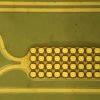Patients who have had spinal cord injuries suffer from not only paralysis of their limbs, but also from other complications often including a loss of bladder control. In previous experiments, Dr. Edgerton from the University of California, Los Angeles and collaborators at University of Louisville, used electrical stimulation to allow four patients to voluntarily stand and perform simple movements. In a new study, partly funded by the National Institute of Biomedical Imaging and Bioengineering, researchers are using the previous findings to to help identify and optimize ways to use electrical stimulation to bring back bladder control in rats.
In the basic protocol, an electrical epidural stimulator is implanted into the spine which allows researchers to control electrical signals. In the study at UCLA, the researchers observed 10 SCI (spinal cord injured) rats that were trained for six weeks with electrical enabling motor control (eEmc) and a group of 5 untrained rats. The rats in the experimental group were trained to empty their bladders while stepping on a treadmill and the rats in the control were not. The group found that the extra sensory input provided by the treadmill training improved bladder response.
A second experiment was also done by the researchers on trained SCI rats that were held by a harness which allowed their lower limbs to touch the ground. A catheter was used to infuse a saline solution into their bladders. Varying levels of eEmc stimulation were applied to determine the optimal amount for spontaneous release of the bladder. The researchers found that the emptying was best when there was a relatively low level of stimulation. This study shows great promise for rehabilitation and improving the quality of life for those that suffer from spinal cord injuries.
source:plosone.org
Electrical Stimuli Induced Bodily Control in Spinal Cord Injuries

